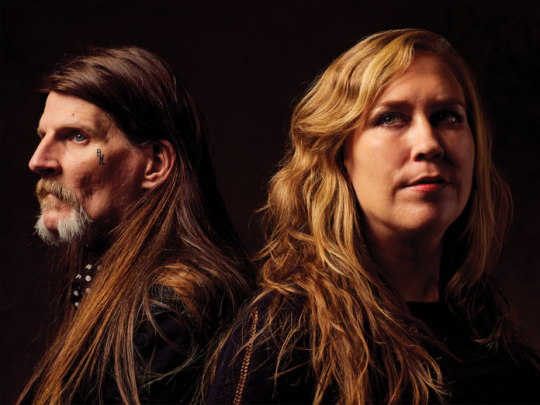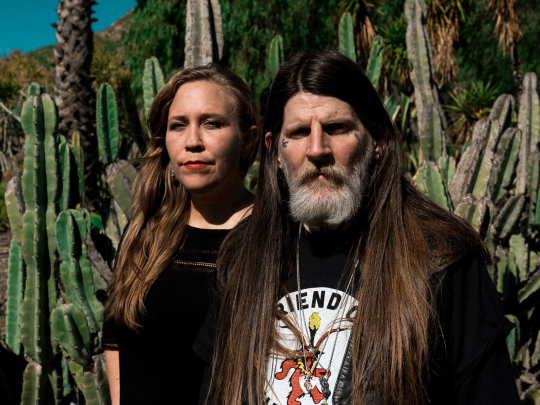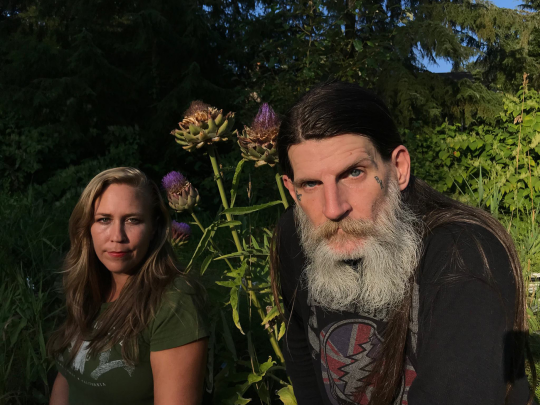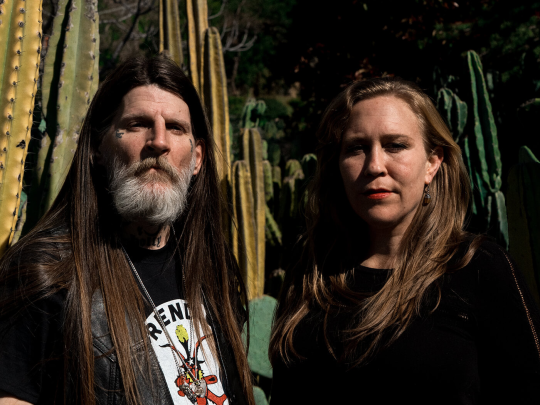Earth’s trajectory is not so much of an orbit as it is a deviation. For the past three decades, the only constant for the band headed by Dylan Carlson has been change – which is ironic for a group whose music relies heavily upon repetition.
Earth started out with ground-shaking seismic drone metal on 1993’s Earth 2, then took a left turn in 2005 into the arid West with the Morricone-inspired Hex; Or Printing In The Infernal Method. Almost a decade later, they ventured into meditative rock with Primitive And Deadly.
Now, the band have purged themselves of any embellishments, stripping instrumentation down to Carlson on guitar and bass and Adrienne Davies on drums and percussion. The upcoming record, Full Upon Her Burning Lips, is a lesson in austerity, and spotlights the duo’s sonic symbiosis.
Ahead of the release, we speak with Carlson about the record, his fascination with Telecaster pickups and his favourite collaborations thus far.

Dylan Carlson (left) and Adrienne Davies of Earth
The new album sees Earth stripped down to the core duo of you and Adrienne Davies. Can you shed more light on this decision?
Well, I’ve been playing with Adrienne for almost 20 years now, and on previous albums, I’ve been fortunate enough to play with a lot of amazing players, but I really wanted this album to focus on the two main members at this point. Just because we really haven’t done that since, probably, Hex; Or Printing In The Infernal Method.
I also felt like live drums have always been a big part of what Earth does, but that has never come across as fully on record. You know, because when you’re recording a bunch of different instruments, you need to leave room for stuff, and I always felt like the drums didn’t show the full potential that Adrienne’s capable of.
And then also, I’ve always sort of been the guy that holds everything down with my guitar and let a lot of other instruments carry the melodic work – whether it’s cello or keys or stuff like that. So I sort of wanted it to just be the two of us showing off the best of our abilities.
The previous records, they’ve all been very lush sounding and I wanted this one to be very present and dry, and upfront. Using the 70s style, you know, where I was running two amps for the basics and hard panning guitars left and right – the kind of stuff that you just don’t really hear any more on record.
Can you tell us a little more about the title Full Upon Her Burning Lips?
I’m always trying to find titles that I feel are numinous and open to multiple interpretations. Many of them, I don’t necessarily see and people tell me about them later. Like someone recently asked if [the title] was about the moon because of the “full upon” bit – which I hadn’t thought of.
I feel like music is a sensual and sensuous experience, so I wanted a title that could evoke that. Originally, the cover idea I had for Primitive And Deadly was going to be much sexier than it turned out. I was sort of on a Scorpions jag at the time [laughs]. I think a lot of music now is missing that element. There’s so much music that’s hyper-male. To me, Metallica is a perfect example – nothing in their music or lyrics reflect the idea that there’s a feminine principle to the universe. So, I guess that’s where it came from.
You mentioned in a statement that you like the “limiting of materials to force oneself to employ even more creatively”. How did that reflect in terms of guitar tone for this album?
For this one I basically used a limited number of effects. I used my live rig, which was like a compressor, an overdrive, a Uni-Vibe and a delay. I mean I used one other overdrive for some cleaner textures and an auto wah on one track, but I pretty much tried to limit it to just the pedals that I use live.
I tried to get the most out of them. For example, I’ve used the Uni-Vibe for a long time, but I’ve always just used the vibrato setting. I never thought the chorus was very useful, and then on this album, I figured out a bunch of really cool sounds with that setting. So that was fun to use in a different way than I normally do.

Image: Sean Stout
A lot of artists tend to compose instrumental music around tension and release. Is that an approach that you take as well?
I guess so, but I don’t know if it’s a conscious one. I feel like all songs should have some kind of arc – I call it a “narrative arc”. Although [with instrumental music] it’s very loose, as there’s obviously not any lyrics telling you what the story is. I sort of – in this very abstract sense – feel like songs and albums should still have a narrative arc. And I hope we convey that in the way that I put stuff together.
Again, it’s a sort of an abstract notion of a narrative, but you know, a song should start somewhere and then go somewhere, in some sort of rudimentary sense. I think that’s why, with instrumental music, the song titles become important. It’s the only way of conveying some kind of narrative with language.
I feel like music is a language in and of itself, and [communicates] in a different way. Music is simultaneously more immediate and more abstract in its meaning. With instrumental music, the audience is also participating in the creation of the meaning or the narrative or the imagery.
It’s not like songs with lyrics where it’s like “Oh my baby left me” or whatever. With instrumental music, it’s more challenging.
This album has a lot of minimalism and repetition. How do you make repetitions sound like progression to the listener?
With repetitive music especially, be it like the riff or the melody or whatever, it should be something that you want to hear again. So I think crafting really memorable riffs is key. They should be something that you want to hear again, and the riffs themselves should have some kind of arc to them as well – so that you’re getting mini arcs that build up to a bigger arc.
That’s one thing I’m constantly trying to do. When I come up with a riff it’s like “Oh, is this something like worth repeating?” There’s that thing that great riffs have where they make you want to hear them again. Whether they’re catchy or whatever, I feel like they should be strong enough – and interesting enough – that they bear repetition.

Image: Holly Carlson
Folklore is a major theme of this album, as it is with much of your work. What draws you to it?
To me, with the music I make, I want it to be timeless and feel like it’s always been there. Folklore has stories and knowledge that have been around forever, transcending cultures. I also feel like, especially with rock music – for lack of a better term – and American music, are all originally from folk sources. You know, blues, jazz, country, rock ’n’ roll – the music is not “high culture”. It’s not like classical music in that it wasn’t created by rich people for other rich people.
It’s popular music from the people, embedded in the salt of the earth, and it’s the same with folklore. It’s interesting and it’s numinous. It’s got a quality of timelessness, like something that’s always been there and that goes along with what I try to do hopefully musically.
Has your gear changed much over the years?
Yeah, I would say so. When I first came back to guitar playing, I hadn’t had a guitar for at least four years. So when I came back to guitar in 2001 or 2002, I was really into gear and was always buying petals. I guess you could call it GAS. But along the way, I realised that it didn’t really matter what I played, it was going to be me like regardless. And so I got a lot less gear-obsessed.
I like gear obviously – I mean, I love guitar – and I’ve found things that allow me to translate what’s in my head better, but I don’t feel like they’re necessary. I’m going to sound like me regardless of what I’m given. I think a lot of people are always looking for that “magic box” or this amp or that amp. At the end of the day, it’s you, you know?
The gear I do get now, I get it because I like how it sounds – which is the most important thing – and then whether it’s functional and helps me with touring. Number one is the sound and number two is functionality and whether it makes my life easier. Those are sort of two of my guiding principles.
Right now I play my live rig which I’m very happy with because I discovered these Trace Elliot Elfs, 200-watt heads that weigh like a pound – I’ve got two of those. And then one has a 1×12 Dietz cab, which I love. The Jesus Lizard guys use them, and Buzz [Osborne] has one. I didn’t know about them before, I was just in Austin and I needed a cab. Yeah, it weighs a shit-tonne, but that’s the only downside to it. It’s got wheels, but it’s a little monster. Then for the other one, I have a 1×12 Mesa cab that’s semi-open.
And then I recorded the album with and did my solo tour with a Burman – it’s a British amp from the early 70s. They were a company out of Newcastle and they basically built these 100-watt power amps called the “Slaves” which ran for either KT66s or EL34s – mine’s got EL34s – and then they did various preamp modules. So they were kind of ahead of the curve, in a certain way.

Image: Sean Stout
You’ve obviously played a lot of guitars over the years. Do you have any favourites?
Yeah, my favourite guitar is the one my wife Holly bought. It has an alder Strat body, and then we had our friend, this artist Jason Borders, carve and stain it. It has no finish. It’s got a Fender neck, the classic player one, with a 12-inch radius pau ferro fretboard, and then I’ve got a brass tremolo. I love brass, I’ve had brass on pretty much all of my guitars that I can. This guitar’s also got a brass bridge and a brass nut.
And then I’ve been running a DiMarzio Fast Track Tele bridge pickup, DiMarzio Cruiser in the middle position, and a DiMarzio Air Classic in the neck. I’m a big DiMarzio fanboy, as you can tell [laughs].
Oh, and this guitar has a little thing called the StratoBlaster which was made by Alembic. It’s a little boost switch – I have mine set for about plus 7- or 8dB, but you can go all the way to 14dB. That’s nice if you want a little bit of oomph.
I have a Tele, it was one of the Roadworn ones which I guess came out in the mid-2000s. That’s got a DiMarzio Tone Zone Tele bridge and a Seymour Duncan Little ‘59 in the neck.
In Europe, I have two guitars that live in a warehouse. I have an Epiphone SG. That one’s got a DiMarzio Tone Zone Tele bridge pickup and a Super Distortion in the neck. I was in a big Jerry Garcia phase then so I got a OBEL (or On-Board Effects Loop) on it, although I very rarely used it [laughs]. And the other’s an Epiphone Explorer that has a DiMarzio Super Distortion Tele bridge pickup. I basically put Tele Bridge pickups in all my guitars.
Some of my guitars have names. Like my favourite one – the Strat or Hollycaster – I call “The Fox”. Tele is “The Cat” and the SG is “The Goddess” because it has a big sticker of Tara Guanyin on it.

Image: Sean Stout
Do you achieve noise through the amps?
I use a lot of gain. Well, maybe not a lot of gain but I push the amps with the compressor and overdrive. With the 200-watt headroom, you’re not going to make it break up, so the tone is really a combination of pickups, overdrive and my hands. It’s not the amp. Same with the Burman – it’s a 100-watt – so the headroom’s massive.
If I’m playing a smaller tube amp, like when I had a 50-watt Plexi for a while, I didn’t use overdrive. I just hit the front end hard with the compressor. That was still like, loud as fuck. Over the years, I’ve come to understand headroom and the fact that no one really needs anything more than 50 watts. Even that is overkill, really, for most venues. Back in Earth 2 days, when I didn’t know any better, and I was young and could lug a shit-tonne of gear, it was like, “Oh yeah, let’s have, all this ridiculous amount of equipment!”. Back then most soundmen didn’t even bother mic-ing us, you know? Now I understand to let the PA do the heavy lifting.
I understand we all grew up on the cool pictures of [Jimi] Hendrix in front of a wall of Marshalls. But there were no PAs and they were playing outdoors half the time. Of course, you need like 25 Marshalls or whatever! It was a different time, with a 100-watt head now you’re never going to get to that sweet spot at a volume that’s not going to kill people.
Let’s talk about collaborations for just a second. What would you say has been your best experience so far?
Well, I love working with Kevin [Martin, aka The Bug]. It’s a whole different world than the one I am used to inhabiting. So it’s very fun for me in that way because I just get to be the guitar player and be creative.
I also love Emma [Ruth Rundle]. I think she’s an amazing musician and a wonderful human being, so that was enjoyable. And with Maddy Prior, that was super because obviously I was really into English folk. Yeah, so getting to meet an OG [laughs] and she was a lovely, lovely woman and really easy to work with. She had written a song and asked me to play guitar on it and I got to just come in and do it.
They’re all incredibly talented and really lovely people, so they’ve all been a real pleasure to work with.
What was recording Concrete Desert like? Would you do something like that again?
Yeah, I’ve been talking to Kevin about it! [Concrete Desert] was our very first collaboration, and he basically sent me the tracks and I played guitar and sent them back. So we actually hadn’t even met in person at that point. I actually just ran into him in on the street in Krakow because we were both playing the same festival.
Then Ninja Tune wanted us to play this anniversary party in LA together, and he had this material and was like, “Hey, why don’t we do this again?” and we were actually in the studio together for a couple days. I mean, he’d already generated much of the material but then after I put my guitar on, he went back and changed it a bunch. He told me he got new ideas from the guitar parts and kinda tweaked it.
But yeah, hopefully the next time we work together we can do it with both of us in the studio, building stuff from the ground up. I don’t know when that’ll happen, but we definitely want to do something together again.
Are there any other guitarists you feel are pushing the instrument to the bleeding edge?
I think Oren Ambarchi is pretty amazing. There’s probably some guys I’m not aware of, but I know Oren and think he’s a pretty good dude. I’m a rock dude and like the fact that he still manages to inject rock into [his music] in some weird way, like with that album he did with the Ace Frehley cover, for example. I think he’s got a lot of swagger to it that others don’t have.
The Rig
- Main Guitar: The Fox aka Hollycaster (see above for details)
- Amp: Live – 2 x Trace Elliot ‘Elf’ heads (200w solid state) each with 1×12 cab (a Dietz and a Mesa). Recording – Early 70s Burman (100w power amp w/ EL-34s) and a pre-amp module and a DV Mark Micro 50 (50w solid state)
- Effects: MXR Custom Comp, MXR Shin-juku Drive, Dunlop Uni-Vibe chorus/vibrato, Dunlop Echoplex Delay, Korg Pitchblack tuner (1st version)
- Strings/Accessories: Dunlop Performance Plus Nickel .09-.42, Dunlop Primetone 3mm picks and various other Dunlop picks all around 2mm
Full Upon Her Burning Lips is out 24 May. More information at thronesanddominions.com.
